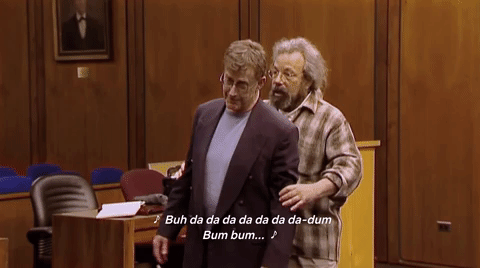Netflix’s The Staircase
"Good, and that's just the deal. You may misspeak - a word like 'shit' may come out, you may make a mistake. BIG. DEAL."
- Michael Peterson's witness coach, as Peterson prepared to stand trial for the murder of his wife in 2001.
Okay, this might be a bit confusing - let’s back up briefly. I was initially stumped by what to write about over the summer, so my friends suggested that I discuss legal aspects of various crime shows. I'm a HUGE fan of true crime and love watching documentaries, listening to podcasts, and reading books on the subject, so I thought that was a great idea! I don't like fictional shows as much - there's just something about the real thing that's incredibly fascinating. But I understand that CSI Miami and Narcos are What The People Want, so I'll try to do a mix of the two.
This week's discussion is based on the Netflix documentary called "The Staircase." If you haven't seen it, no worries - I'm going to focus on/explain some of the trial preparation depicted. If you have any shows that interest you or want to discuss, leave me a comment! But we'll start with the suspicious death of Kathleen Peterson.
A brief background (no spoilers on the trial). In December 2001, Michael Peterson called 911 to report that his wife Kathleen had fallen down a flight of stairs in their Durham, NC home. She was unconscious, and died soon after medical personnel arrived. Though Michael claimed Kathleen had drunkenly fallen down the stairs - which he didn't hear because he was outside sitting by the mansion's pool - the suspicious amount of blood convinced authorities that Kathleen was murdered.
As the husband and only person present, Michael immediately became suspect #1. Those suspicions grew after police found evidence of homosexual relationships hidden on his computer, and discovered that another female acquaintance of Michael had ALSO been found dead at the bottom of the staircase 18 years earlier.
Yikety yikes, yikes yikes YIKES.
As I said earlier, this post will focus largely on Michael Peterson's trial preparation. The following are six things the defense team did in the months leading up to the trial:
1. BLOOD SPLATTER EVIDENCE
The blood on the staircase comes up immediately because, without eyewitness testimony or a murder weapon, the spatter patterns *could* be used to identify how events transpired. Blood spatter evidence is considered reliable in a courtroom, but its scientific validity is extremely questionable. As with many things involving expert witnesses - if you get the right witness, you can get whatever 'evidence' you want.
Expert witnesses can be extremely convincing, and sometimes very misleading. In The Staircase, the defense gathered a bunch of North Carolina residents to present and evaluate their blood spatter expert. Bottom line - it did not go well. The residents (read: potential jurors) found the testimony confusing, the expert too biased, and the version of events hard to follow. Not a good start for Mr. Peterson.
2. VOICE RECORDINGS
According to Michael Peterson, he didn't hear Kathleen fall, or call for help, because he was sitting by their pool during the incident. To give this story more credibility, the defense decided to test it out. They set up a recording device that snaked from the staircase to the chair where Michael was sitting, and then played a recording of a woman yelling for help at a normal/loud volume. Maybe I'm deaf, but I didn't hear the woman over the bubbling water. A win for the defense team!
3. SURVEY OF PEERS
Now, THIS is fascinating. After the prosecution discovered evidence of Michael's affairs with various men, the defense counsel decided to canvass 400-500 people about their attitude towards homosexuality. The defense knew that Michael's affairs would star as the prosecution's evidence for motive, and needed to figure out how to best combat that angle. The canvassing apparently cost between $35K and $40K, and Michael Peterson later revealed the total cost of the trial was $750-$800K. He then said, and I quote - "what do people do, who don't have any money?"
Great question, Michael. I'll leave that for our criminal justice system to ponder.
Apart from the blood splatter testimony and homosexuality views, the defense also tested how potential jury members would respond to the "striking coincidence" of Elizabeth Ratliff (Michael Peterson's female friend) found dead at the bottom of a staircase eighteen years before Kathleen. I immediately assumed this would be damaging to the defense, but the think tank said the previous incident actually made them respect Michael Peterson more. Why? Because he adopted the dead woman's two children afterward.
4. GOOD FACTS/BAD FACTS
This hit home because I did something similar in the JAG office last week! In this scene, the defense team sat in a semi-circle and called out various facts from the case, labeling them as a "good fact" or a "bad fact." One lady wrote them all down, good facts in green and bad facts in red. As you can see above, there were PAGES.
My favorites were the facts that could be good or bad, depending on how they were raised in court. These facts raised a lot of discussion among the lawyers, and even inspired some impromptu "witness questioning" to see how various angles would work on the stand. It seemed like a very productive exercise!
5. WITNESS PREP
My 1L ignorance shows on this one. I knew witness prep was a thing, but I didn't know actual EXPERTS prepared a witness for the stand. It was fascinating to see the witness coach work on Michael Peterson, and equally cool to see the defense counsel go full Lawyer Mode on him.
Initially, the defense expressed hesitation about using Michael as a witness. One lawyer stated that he never puts the accused on the stand UNLESS they can provide very powerful testimony that can't come from anywhere else. They're not afraid of Legally Blonde-style admissions, necessarily - but on cross-examination, a prosecutor can make the accused look REALLY bad. Therefore, the defense needed to see how Peterson responded to questioning and come across to a jury while also teaching him how to avoid opening himself up to avenues of attack. Definitely complicated, probably good (for them) that an expert was involved.
6. ALTERNATE THEORIES OF THE CASE
The standard for a conviction in court is "beyond a reasonable doubt," and the most effective way to induce doubt is to paint convincing, alternate explanations of the facts. The prosecution endeavored to prove that Michael Peterson bludgeoned Kathleen Peterson to death - therefore, the defense needed a counter story that simply made the jury go, "well, maybe..."
Early in The Staircase, the defense debated whether to present a story involving an outside intruder or an account where Kathleen fell down the stairs by herself. (There's also a third, crazier account that comes up later but I won't spoil it). Though there were some attractive points to the outsider intruder story (no DNA, no murder weapon, Michael could have been by a pool, etc.) they chose the fall because they believed it was more plausible. This, in turn, shaped the entire way the defense built their facts, chose their witnesses, pursued evidence, and crafted a version of events - bottom line, NOT something you want to mess up.
7. OTHER
There are two other pieces I found fascinating, even if they weren't necessarily "trial prep." First of all, Peterson was present and actively PARTICIPATED in many of these activities, and a ton of the work was done in his own home. In the entire documentary, I only saw him get upset once; otherwise, he calmly discussed his wife's death as if he were simply another member of the defense team. To be honest, it unnerved me. It's dangerous to judge someone's guilt or innocence based on how they act (everyone reacts differently to stress, pain, fear, anger, guilt, etc) but it's also pretty human to do just that.
I also didn't understand how a crew could be IN the room filming without sacrificing the attorney-client privilege. Basically, private communication between an attorney and their client is confidential, but that privilege is lost the minute someone beside the attorney or client is included. Therefore, ANYTHING said in the presence of the film crew could potentially be disclosed to the prosecution.
Of course, the defense was well aware of this (and initially reluctant to allow filming). The lead defense attorney, David Rudolf, only agreed because of "three layers" protecting the attorney-client privilege. First, the film crew was filming for him and defense purposes until after the trial, so technically their work was covered under the privilege. Second, the crew mailed all raw footage back to France so that if the prosecution subpoenaed the tapes, they'd have to recover it from Paris (MUCH harder than getting it from inside America). Third, none of the tape would be shown until after the trials and appeals were all complete.
Overall, I was fascinated by the first few episodes of this documentary. Here's what I think happened: the first woman, Elizabeth, actually did die from a brain hemorrhage and falling down the stairs in her home. Michael Peterson saw that and used the same concept to kill Kathleen eighteen years later. Of course, it doesn't matter what I think - the jury is already in, so to speak. But it was fascinating to watch trial counsel built a case in Michael's defense and I can only hope I'll do similar things in the future!






